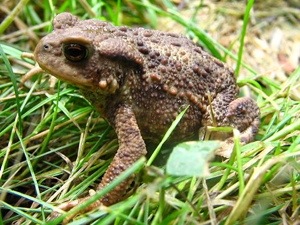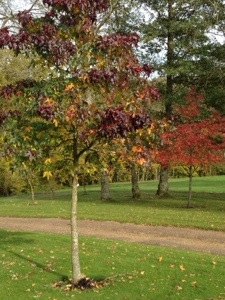The hedgehog…Gardeners friend.
I had the pleasure of getting up close and personal with one of our native mammals today. The humble and unassuming hedgehog.
Hedgehogs share distant ancestry with shrews and have changed little over the last 15 million years. Like many of the first mammals, they have adapted to a nocturnal, insectivorous way of life.
The name hedgehog came into use around the year 1450, and was derived from the Middle English heyghoge, from heyg, hegge (“hedge”), because it frequents hedgerows, and hoge, hogge (“hog”), from its piglike snout.[4] Other names include urchin, hedgepig and furze-pig.
This little fellow had managed to fall into a space it was unable to get out of and was very lucky that I spotted him. I am not sure how long he had been down there, but decided that it was advisable to leave him where he was and let him finish his sleep and release him at the end of my working day when darkness would be not far away. I did leave him some water though just in case he was desperate.
>
Toad update
As some might have read in one of my previous posts I found dead and dying toads which I found to be worrying.
I sent them off to London for post mortem and this is what the came back with…..
XT0293-14 Common toad
This was an adult male common toad in normal body condition with good leg muscle bulk. The carcass was in a moderate state of decomposition which limited examination of some body systems and precluded microbiological examination.
There was clear evidence of trauma with blood-stained fluid under the skin around the inguinal region and the neck /shoulder region. The lungs were semi-inflated and contained blood-stained frothy fluid. Free blood clots were also present in the body cavity. No fractures or evidence of puncture wounds was detected.
The stomach contained a small amount of semi-digested invertebrate food remains and there were scant intestinal contents only.
Some of the heart muscle was black in colour; organ pigmentation is commonly seen as a normal finding in amphibians so this is an incidental finding.
A small number of ciliates and flagellates were detected in the intestinal contents and are likely part of the normal gut flora.
A skin swab was collected and has been tested by PCR for chytrid fungus (Batrachochytridium dendrobatidis); this sample was negative. A liver sample was tested by PCR for ranavirus: this sample was negative.
The findings are consistent with trauma as the cause of death; however, the cause of the trauma remains undetermined. Given the findings in the other two cases, predation remains a possibility.
XT294-14 Common toad
This was an adult male common toad in normal body condition with good leg muscle bulk.
There was clear evidence of trauma consistent with predation, likely by a small mammal. A puncture wound was visible over the back and a pair of puncture wounds (8-9 mm interval) was visible in the deeper tissues, associated with fracture of the vertebral column. Free blood clots were present in the body cavity.
The liver surface had an unusually prominent network of surface vessels; a sample has been taken and histopathological examination will be performed in due course.
A small number of adult helminths were detected in the intestinal contents and are considered an incidental parasitic infection; flagellates were also present and are likely part of the normal gut flora.
A skin swab was collected and has been tested by PCR for chytrid fungus (Batrachochytridium dendrobatidis); this sample was negative. A liver sample was tested by PCR for ranavirus: this sample was negative.
The findings are consistent with predation as the cause of death, likely caused by a small mammal. Post-mortem examination revealed no evidence of significant underlying disease that may have predisposed to predation.
XT295-14 Common toad
This was an adult male common toad in normal body condition with good leg muscle bulk.
There was clear evidence of trauma consistent with predation, likely by a small mammal. A single puncture wound was present in the midline of the back associated with a vertebral column fracture and local haemorrhage extending into the inguinal region. In addition there was evidence of subcutaneous haemorrhage (bleeding under the skin).
Flagellates were detected in the intestinal contents and are considered likely to be part of the normal gut flora.
A skin swab was collected and has been tested by PCR for chytrid fungus (Batrachochytridium dendrobatidis); this sample was negative. A liver sample was tested by PCR for ranavirus: this sample was negative.
The findings are consistent with predation as the cause of death, likely caused by a small mammal. Post-mortem examination revealed no evidence of significant underlying disease that may have predisposed to predation.
I am now on a mission to find the culprit who had it in for the toads…….
Wildflower meadows.
I have just cut the paths through the wildflower meadows for the first time this year, but have made a point of making them a little wider than last year. Towards the end of the season some of the plants and grasses had reached such a height that they ended up toppling, falling over the path and making it difficult to pass. Hopefully making them another mower-width wider will compensate for that.
The first flowers are out in the meadows too. Our beautiful cowslip….
t
New link
Hi guys, have decided to set up a Facebook page.
The link is
https://m.facebook.com/Thoughtsfromthegarden
Be good to see you there 🙂
Toad in a hole.
It is now time for the toads to start their spawning, but unfortunately, this week I found several dead ones and about 10 that were suffering quite badly, not being able to use their back end properly and just generally lethargic.
Amphibians are one of the first creatures that suffer from any harmful bacteria or pollution so this sent alarm bells ringing seeing them in such poor state, so I decided to register my concerns with ‘Garden Wildlife Health’. After speaking to a vet it was agreed that this needed further investigation and so three of the toads were packaged up and send to the Institute of Zoology in London for post mortem.
They have promised to let me know of the outcome, so as soon as they do I will let you know
.
Time waits for no man….or gardener!?
What a wonderful week or so! My head has been to the grindstone with so many varied jobs. I have finished pruning around the house which included the honeysuckle and the fig, planted numerous shrubs and plants that were looking for their ‘forever’ homes. I have finished planting the Photinias to replace the standard roses, tidied the herbaceous borders and pruned the hydrangeas. I also relented and tackled the first lawn cut. Phew!!!
I find it always enjoyable to finally be able to put my back into work after wintertime, shrugging off the cold, damp weather, shedding all the coats and jumpers that have kept the worst of the weather from penetrating my bones, and taking deep lungfuls of optimistic air which holds the scent of Spring.
The animals are finally feeling it too. At long last the frogs have returned to the ponds for spawning, albeit much later than last year despite the mild temperatures through this winter. Their gentle croaks are soothing in a funny sort of way. In another week or two it will be the time for the toads with their gorgeous grumpy faces.
I have female ducks scattered around the gardens sitting patiently on their eggs waiting for them to hatch. I love watching the ducklings first outing, being led by mum, down to the ponds. I will try to get a photo…
Forward March!
Two days of fine weather has given me the chance to really knuckle down in the gardens.
I managed to reach the halfway point of planting the Photinias. Only another four to go. Trying to marry the box hedging back in was a bit of a task, but it looks good and will only look better when I trim the hedges in July.
Before
After
I also tidied around the house, cutting dead foliage off and putting fresh compost over the top to freshen up. I did find some horrible little blighters though!! They had been munching the roots of the heuchera making them very sick looking and lacking in vigour. I hope I have saved the plants in time.
The culprits!
In the greenhouse I decided it was time to pot on the tomatoes as they were still growing well and ready for their own pots. I have 83 plants all told. Enough for just a few jars of chutney I think!!?
Suns shining…the weather is sweet yeah
Everything had a spring in its step today. Walking down to work this morning the birds were singing their hearts out, so much so that I thought I was hearing the waterfalls from the ponds, only to find out when I got closer it was a babbling from hundreds of birds.
The gardens are marching forward. Daffodils poking their cheerful heads out to meet the sun, buds on the bushes and trees starting plump up with the anticipation of unfurling their leave to greet the warmth. The grass too has started its growth. Mind you, I always leave the first cut of the season as long as I can, as I know that once you start it encourages it to grow at a faster pace….and the mowing season goes on a long time, tying you up away from other tasks. I will try to do as much as I can with other jobs around the garden before I commit myself to the lawn cutting.
Today I started planting the Photinias, which was quite time-consuming. I had to remove the centre of the ‘box’ crosses, plant the photinia, then replant the box to marry back in to the original shape. Should look good when the task is finished, but with just me on the job I feel it will take me til the end of next week before it is completed. Luckily I have plenty of patience and stubbornness….traits which are definitely needed in gardening.
New arrivals
The new shrubs arrived today from Italy at the nursery we use here in the UK. Eight photinia ‘red robin’ to replace the standard roses that are looking rather weak in the back part of the gardens.
Photinias have really gone up in my estimation over the years. I first had dealings with them while self employed and working for an old gent who’s garden was in the main totally evergreen. He had several of the dotted about within the mix of euronomous, aucubas, grisilinias and the likes. Having a good evergreen with a red tinge brought a depth to the garden and their new spring growth lifted the garden with their vibrancy. They responded incredibly well to pruning too.
The new ones I feel will lift the area in wintertime when their colour will be a welcome sight.





























